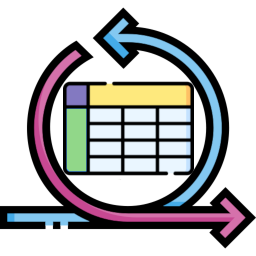TabulaRDF - Functionality for DataFrame to RDF conversions.
Although TabulaRDF was primarily designed for table to RDF conversions, the TemplateConverter class should be general enough to allow conversions to basically any target format.
Just like the TemplateGraphConverter class parses renderings into an rdflib.Graph instance, renderings could e.g. also get parsed into an lxml.etree.
- python >= 3.11
TabulaRDF is available on PyPI:
pip install tabulardfAlso the TaCL CLI can be installed with pipx:
pipx install tabulardfFor installation from source either use poetry or run pip install . from the package folder.
TabulaRDF provides two main approaches for table conversions, a template-based approach using the Jinja2 templating engine and a pure Python/callable-based approach.
Also a CLI for template conversions is available, see TaCL below.
Template converters are based on the generic TemplateConverter class which allows to iterate over a dataframe and pass table data to Jinja renderings.
Two different render strategies are available through the render method and the render_by_row method respectively.
- With the
rendermethod, every template gets passed the entire table data as "table_data"; this means that iteration must be done in the template. - With the
render_by_rowmethod, for every row iteration the template gets passed the current row data (as "row_data") only; so iteration is done at the Python level, not in the template.
The TemplateGraphConverter class uses the render_by_row method and parses renderings into an rdflib.Graph instance.
import pandas as pd
from jinja2 import Template
from tabulardf import TemplateGraphConverter
table = [
{
"id": "rem",
"full_title": "Reference corpus Middle High German"
},
{
"id": "SweDracor",
"full_title": "Swedish Drama Corpus"
}
]
dataframe = pd.DataFrame(data=table)
template = Template(
"""
@prefix crm: <http://www.cidoc-crm.org/cidoc-crm/> .
@prefix rdf: <http://www.w3.org/1999/02/22-rdf-syntax-ns#> .
{% set acronym_lower = row_data['id'] | lower %}
<https://{{acronym_lower}}.clscor.io/entity/appellation/1> a crm:E41_Appellation ;
crm:P2_has_type <https://core.clscor.io/entity/type/appellation_type/full_title> ;
rdf:value "{{row_data['full_title']}}" .
"""
)
converter = TemplateGraphConverter(
dataframe=dataframe,
template=template
)
print(converter.serialize())Output:
@prefix crm: <http://www.cidoc-crm.org/cidoc-crm/> .
@prefix rdf: <http://www.w3.org/1999/02/22-rdf-syntax-ns#> .
<https://rem.clscor.io/entity/appellation/1> a crm:E41_Appellation ;
crm:P2_has_type <https://core.clscor.io/entity/type/appellation_type/full_title> ;
rdf:value "Reference corpus Middle High German" .
<https://swedracor.clscor.io/entity/appellation/1> a crm:E41_Appellation ;
crm:P2_has_type <https://core.clscor.io/entity/type/appellation_type/full_title> ;
rdf:value "Swedish Drama Corpus" .This is not a simple text rendering (note that the prefix declarations are not repeated) but an rdflib serialization!
TemplateGraphConverter.serialize is a proxy for rdflib.Graph.serialze, so any serialization format can be generated.
TabulaRDF provides two main approaches for pure Python/callable based table to RDF conversions, the RowGraphConverter class and FieldGraphConverter class.
RowGraphConverter takes a dataframe and a Python callable which takes a dict parameter and is responsible for returning a graph instance;
for every row iteration over the dataframe this callable gets passed the row data as a dictionary; the generated subgraphs ("row graphs") are merged into a main graph.
import pandas as pd
from jinja2 import Template
from tabulardf import RowGraphConverter
from rdflib import Graph, URIRef, Literal, Namespace
from rdflib.namespace import RDF
table = [
{
"id": "rem",
"full_title": "Reference corpus Middle High German"
},
{
"id": "SweDracor",
"full_title": "Swedish Drama Corpus"
}
]
dataframe = pd.DataFrame(data=table)
def row_rule(row_data: dict) -> Graph:
crm = Namespace("http://www.cidoc-crm.org/cidoc-crm/")
subject_uri = URIRef(f"https://{row_data['id'].lower()}.clscor.io/entity/appellation/1")
triples = [
(
subject_uri,
RDF.type,
crm["E41_Appellation"]
),
(
subject_uri,
crm["P2_has_type"],
URIRef("https://core.clscor.io/entity/type/appellation_type/full_title")
),
(
subject_uri,
RDF.value,
Literal(row_data["full_title"])
)
]
graph = Graph()
for triple in triples:
graph.add(triple)
return graph
converter = RowGraphConverter(
dataframe=dataframe,
row_rule=row_rule)
print(converter.serialize())FieldGraphConverter on the other hand iterates over every field for every row in a dataframe; it applies callables to every field according to a mapping of column header names and callables responsible for returning a subgraph per field ("field graphs") which are then merged into a main graph.
Callables in such are rule mapping are of arity 3, they receive
subject_field(according to theFieldGraphConverter'ssubject_columnparameter),object_field(i.e. the value of the current field) andstore(a class level dictionary for caching data).
import pandas as pd
from jinja2 import Template
from tabulardf import FieldGraphConverter
from rdflib import Graph, URIRef, Literal, Namespace
from rdflib.namespace import RDF
table = [
{
"id": "rem",
"full_title": "Reference corpus Middle High German"
},
{
"id": "SweDracor",
"full_title": "Swedish Drama Corpus"
}
]
dataframe = pd.DataFrame(data=table)
def id_rule(subject_field, object_field, store) -> Graph:
subject_uri = URIRef(f"https://{subject_field}.clscor.io/entity/appellation/1")
crm = Namespace("http://www.cidoc-crm.org/cidoc-crm/")
triples = [
(
subject_uri,
RDF.type,
crm["E41_Appellation"]
),
(
subject_uri,
crm["P2_has_type"],
URIRef("https://core.clscor.io/entity/type/appellation_type/full_title")
)
]
graph = Graph()
for triple in triples:
graph.add(triple)
return graph
def full_title_rule(subject_field, object_field, store) -> Graph:
subject_uri = URIRef(f"https://{subject_field}.clscor.io/entity/appellation/1")
graph = Graph()
graph.add((subject_uri, RDF.value, Literal(object_field)))
return graph
column_rules = {
"id": id_rule,
"full_title": full_title_rule
}
converter = FieldGraphConverter(
dataframe=dataframe,
subject_column="id",
subject_rule=str.lower,
column_rules=column_rules)
print(converter.serialize())If subject_rule is supplied, subject_field in a column_rule callable will be what subject_rule computes it to be.
As mentioned, store is a class level attribute for sharing state between callables.
Both RowgraphConverter and FieldGraphConverter produce the same output.
TaCL is a humble CLI for tabulaRDF template conversions. [todo: description + examples]

